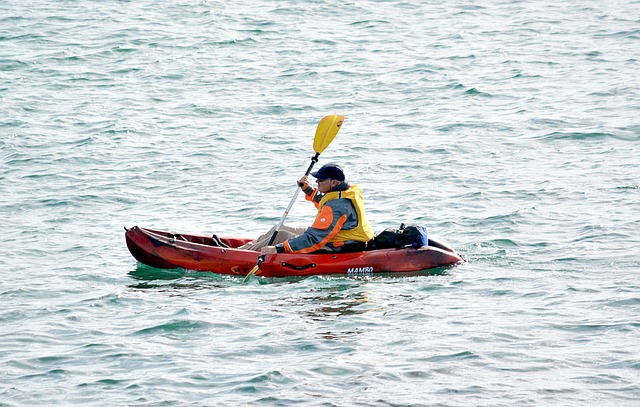Are you ready to dive into the topic of dry bags and discover the perfect size for your kayaking adventures? Well, you’re in luck because today, I’ll be sharing a comprehensive guide on finding the ideal size dry bag for all your needs. As someone who has spent countless hours exploring the waters and discovering the joys of kayaking, I understand the importance of keeping your belongings safe and dry during your excursions.
The last thing you want is to worry about your gear getting soaked or damaged. That’s where a high-quality dry bag comes to the rescue. But with so many sizes to choose from, it can be a bit overwhelming to determine what size dry bag you need for kayaking. Don’t fret, my friend, because I’m here to help you navigate through the maze of options and find the right size dry bag that meets all your kayaking needs.
Throughout this article, I’ll take you on a journey to understand what makes a dry bag essential, the key factors to consider when selecting the size, and recommendations for various kayaking scenarios. So, grab your paddle, and let’s dive right in!
Understanding Dry Bags and Their Purpose
Before I dive into the nitty-gritty of choosing the right size dry bag, let’s take a moment to understand the purpose and importance of these essential pieces of gear for kayaking.
At its core, a dry bag is designed to keep your belongings safe and dry, even in the wettest and most unpredictable conditions. Whether you’re embarking on a peaceful day trip or going on a multi-day kayak expedition, a dry bag is your ultimate companion to protect your gear from water, moisture, dirt, and even accidental submersion.
One of the key features of a good dry bag is its waterproof construction. These bags are typically made from durable and waterproof materials, such as nylon or PVC, with reinforced seams to prevent any leakage. They often come with sealed closures, such as roll-top or zip-lock mechanisms, which create a watertight seal, ensuring that water stays out and your belongings stay dry.
So, why is a dry bag so important for kayaking? Well, think about all the valuable items you may carry with you on your kayaking adventures. Your phone, wallet, camera, extra clothing, food supplies, and other gear are not only expensive but also essential for your safety and enjoyment on the water. Keeping them dry and protected is crucial to ensure a hassle-free and enjoyable experience.
Moreover, a dry bag provides peace of mind. Knowing that your belongings are safe from water damage allows you to fully immerse yourself in the beauty of nature and the joy of kayaking without constantly worrying about your gear.
Whether you’re exploring tranquil lakes, tackling challenging whitewater rapids, or venturing into the open sea, a properly sized dry bag is an indispensable accessory for any kayaker. By choosing the right size, you can maximize your storage capacity and ensure that you have enough space for all your essential items.
Now that you understand the purpose and significance of dry bags, let’s delve into the factors you should consider when selecting the perfect size dry bag for your kayaking escapades.
Factors to Consider When Choosing the Right Size Dry Bag
When it comes to choosing the right size dry bag for kayaking, several factors come into play. Let’s explore these factors to ensure you make an informed decision:
- Trip Duration and Storage Needs: The duration of your kayaking trip is a crucial factor in determining the size of the dry bag you’ll need. For day trips or shorter excursions, a smaller dry bag might suffice to store essentials like snacks, a water bottle, a change of clothes, and your personal belongings. However, for overnight or multi-day adventures, you’ll need a larger dry bag to accommodate additional clothing, camping gear, food supplies, and other necessities.
- Personal Belongings and Equipment: Make a checklist of the personal belongings and equipment you typically bring along on your kayaking trips. Consider items like your phone, camera, wallet, sunscreen, first aid kit, and any specialized gear you require for your specific activities. Different equipment comes in various sizes and shapes, so keep that in mind when choosing your dry bag size.
- Kayak Design and Storage Options: The design of your kayak and its available storage options also play a role in determining the size of your dry bag. Sit-on-top kayaks generally have more open storage areas, while touring kayaks often feature sealed hatches or compartments. Consider how your kayak is designed and utilize its storage spaces effectively. If you have limited storage options, you may need a larger dry bag to accommodate your belongings.
Remember, it’s always better to have a slightly larger dry bag than one that’s too small. You don’t want to cram your items into a tight space, as it can make accessing and organizing them difficult, and it may compromise the waterproof seal of the bag.
In the next section, I’ll explore specific size recommendations for different kayaking scenarios to help you further narrow down your options.
Size Recommendations for Different Kayaking Scenarios
Now that you have a good understanding of the factors to consider, let’s dive into some size recommendations for different kayaking scenarios. Remember, these are general guidelines, and your specific needs and preferences may vary.
- Day Trips and Recreational Kayaking: For shorter day trips or recreational kayaking adventures, a smaller dry bag with a capacity of around 10 to 20 liters should suffice. This size is ideal for carrying essentials like your phone, wallet, snacks, a small towel, sunscreen, and a spare change of clothes.
- Overnight or Multi-Day Kayak Expeditions: If you’re planning an overnight or multi-day kayak expedition, you’ll need a larger dry bag to accommodate additional gear and supplies. In this case, consider a dry bag with a capacity of 30 to 50 liters or more, depending on the duration and intensity of your journey. This size allows you to pack clothing, camping equipment, cooking gear, food supplies, and other essentials comfortably.
- Special Considerations: Photography, Fishing, and Water Sports: If you’re an avid photographer, angler, or participate in water sports like paddleboarding or snorkeling, you may require extra space for your specialized equipment. For photographers, consider a larger dry bag with compartments or dedicated camera gear storage options to protect your valuable equipment. Anglers might opt for a larger dry bag to accommodate fishing gear and tackle boxes. Water sports enthusiasts may need additional space for wetsuits, fins, snorkels, or other gear specific to their activities.
Remember, these recommendations are not set in stone, and it’s essential to assess your specific needs and pack accordingly. Additionally, it’s a good practice to consider compartmentalization within your dry bag by using smaller waterproof or ziplock bags. This allows you to organize and protect different items while maximizing the use of available space.
Next, I’ll provide some valuable tips for packing and organizing your dry bag efficiently.
Tips for Packing and Organizing Your Dry Bag
Packing and organizing your dry bag efficiently is just as important as choosing the right size. Here are 7 valuable tips to help you make the most of your storage space and keep your belongings easily accessible:
- Roll and Seal: Start by rolling your clothing and gear tightly to save space. This not only helps maximize storage but also minimizes wrinkles. Once you’ve packed your items, seal the dry bag by using the roll-top closure or zip-lock mechanism, ensuring a watertight seal.
- Utilize Compartments: If your dry bag has internal compartments or pockets, make use of them to keep items organized. Separate smaller essentials like keys, phones, and wallets in a dedicated compartment for quick and easy access.
- Waterproof or Ziplock Bags: Use smaller waterproof bags or ziplock bags to further compartmentalize items within your dry bag. This method helps keep things organized and provides an additional layer of protection for smaller items like electronics, batteries, and toiletries.
- Heavy Items at the Bottom: Distribute weight evenly by placing heavier items at the bottom of your dry bag. This helps maintain stability and balance while paddling and reduces the chance of your kayak becoming top-heavy.
- Pack Strategically: Place frequently needed items like snacks or a rain jacket near the top of your dry bag for easy access. Less frequently used items can go toward the bottom.
- Protect Fragile Items: If you’re carrying delicate or fragile items, such as a camera or glasses, consider wrapping them in a soft cloth or using protective cases to prevent damage.
- Test for Waterproofness: Before heading out on your kayaking adventure, it’s a good idea to do a quick test to ensure the waterproofness of your dry bag. Fill the bag with a few towels or a piece of clothing, seal it, and submerge it in water for a few minutes. Check for any signs of leakage before packing your valuable items.
The right-size dry bag will keep your gear protected, allowing you to fully enjoy the wonders of kayaking without worrying about water damage.
Conclusion
You have reached the end of this comprehensive guide on finding the perfect size dry bag for your kayaking adventures.
The size of the dry bag for kayaking depends on factors like trip duration, personal belongings, and kayak storage. For day trips, 10-20 liters is suitable, while multi-day trips may require 30-50 liters or more. Assess your needs and choose accordingly.
Now armed with this knowledge, you can confidently choose a dry bag that meets your specific needs and ensures the safety and dryness of your belongings. Whether you’re embarking on a peaceful day trip, an overnight expedition, or engaging in specialized activities like photography or fishing, there’s a dry bag size that’s just right for you.
So, as you gear up for your next kayaking escapade, remember to pack strategically, utilize compartments, and protect your gear with waterproof or ziplock bags. Distribute weight evenly, keeping heavier items at the bottom, and perform a quick waterproofness test to give yourself peace of mind.
Now it’s time to set sail, explore the serene lakes, conquer the challenging rapids, and immerse yourself in the beauty of nature. With the perfect-size dry bag, your belongings will stay safe and dry, allowing you to focus on the joy and exhilaration of kayaking.
Happy paddling, my friend!
Here’s your next read: How To Choose The Correct Kayak Paddle Size? A Complete Guide









